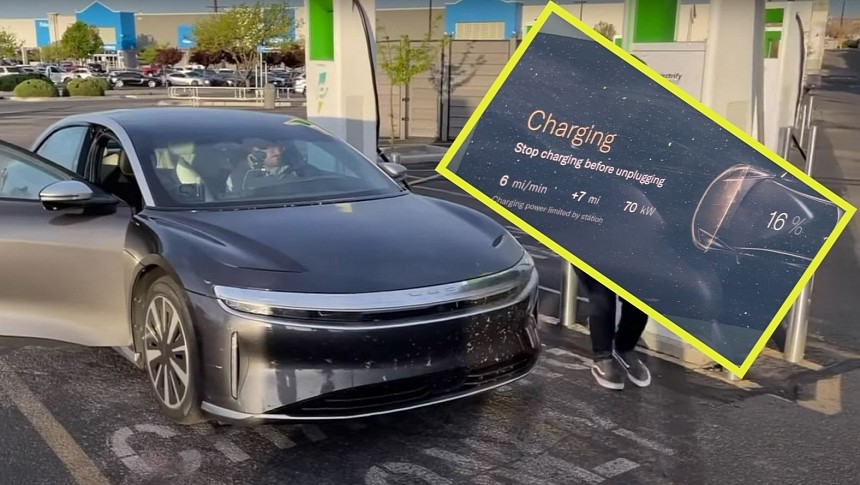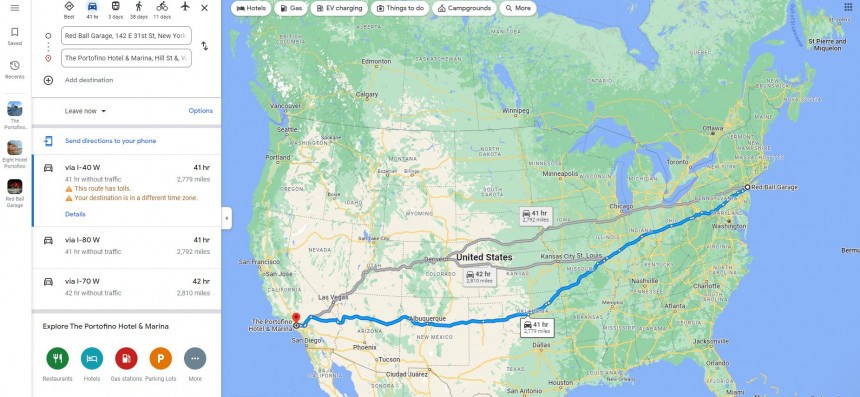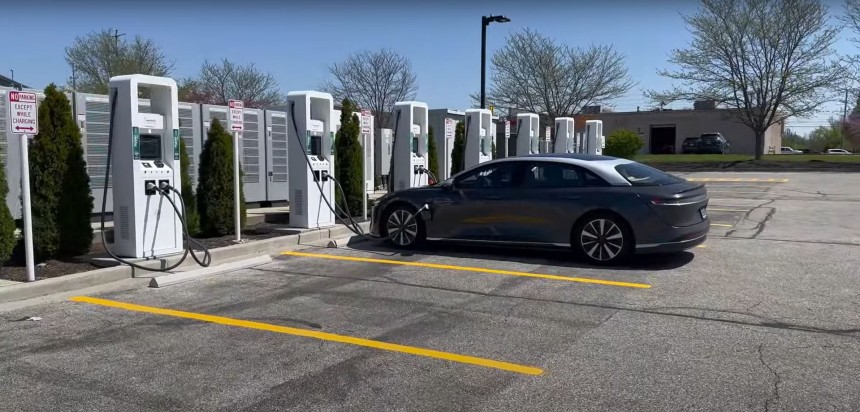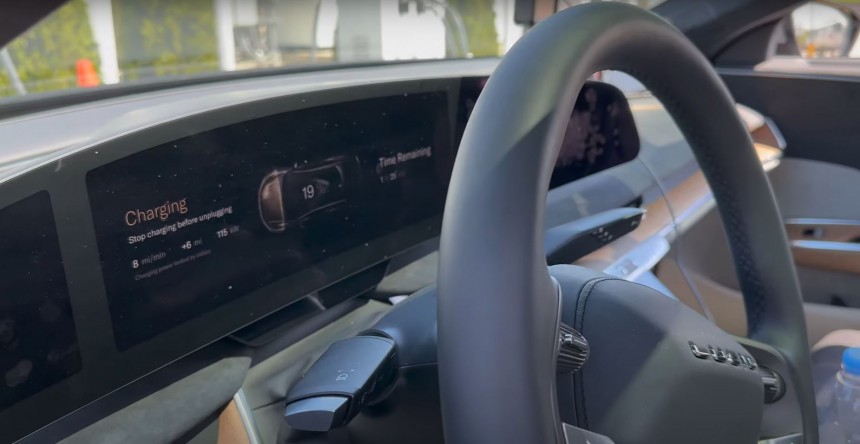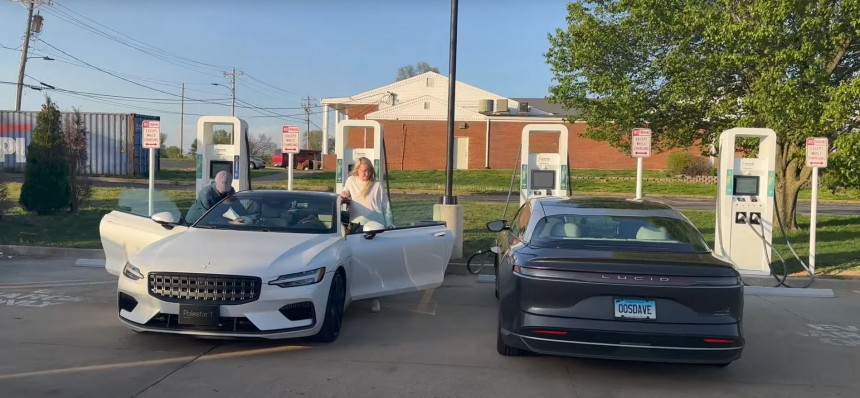Owning a car heightens anyone's sense of freedom, but a couple of courageous people attempt to go even farther by covering great distances in as little time as possible. Since EVs are getting increasingly popular, doing a Cannonball Run with a luxurious Lucid Air sounds like the experience anyone might want to try at some point. However, be aware that establishing a new record might be problematic. Surprisingly, it doesn't have anything to do with the car.
Being able to drive nearly anywhere, at any time, is something most people take for granted nowadays. But it is one of the greatest freedoms most of us experience regularly. However, the recent progress regarding cleaner or zero-emission powertrains has pushed people and businesses to amplify this experience. Everyone wants to show they have the upper hand at some point.
To prove that a specific vehicle is better than its competitors or to display a person's driving skills, the Cannonball Run has been popularized as a simple yet genuine way of ensuring nobody can contest the outcome. Be it efficiency or an improved charging network, something cool may come from such an incredible adventure. Who is going to say that your car needs to be faster if you can establish a new Cannonball record while going from the East Coast to the West Coast or vice-versa?
Google Maps shows that from Holiday Inn, Virginia to the Portofino Hotel, California you'll need around 40 hours of continuous travel to cover the entire optimal route of 2,742 mi (4,413 km). However, the Cannonball Run route that's accepted by most people paying attention to this motoring phenomenon starts from New York City's Red Ball Garage and ends at the same Portofino Hotel we chose for our route. The shortest path is 2,729 mi (4,493 km), but the one recommended by Google Maps is a tad bit longer – 2,810 mi (4,522 km).
That's still pretty far from the overall Cannonball Run record of 25 hours and 39 minutes, set by two guys driving a slightly modified Audi S6. But the gap between EVs and internal combustion engine vehicles (ICEVs) is narrowing, and the zero-tailpipe emission powertrains might soon equal the mightiness of the dinosaur juice-powered cars.
Five people recently gathered and decided to use a fully-loaded Lucid Air Grand Touring to break the EV Cannonball Run record. However, the Out of Spec Motoring initiative was met with several challenges. They did it without informing the automaker or the charging network of choice, which, in our book, is a solid choice. This adventure was kept on the down low until it was made public through a slightly edited three-hour video published on YouTube and available at the end of this article. So, nearly everyone can relate to the issues they encounter.
The EV was bought by the channel owner's dad, who agreed to let them use it for this experiment. Equipped with the redesigned aero wheels that made it more slippery, the unit was rapidly put through a short run-in period that added around 800 mi (1,287 km) to the odometer.
Luckily, it worked just fine. The station replenished the battery at a maximum rate of nearly 250 kW, despite the Air not having too much time to precondition the 112-kWh energy storage unit. In around 14 minutes, the battery recharged to almost 56% from the 22% state of charge (SoC).
The second charging stop went well too, despite the station giving the guys some anxiety at first, but the third stop is where things got complicated. They arrived with 7% SoC, and the first stall didn't work. Luckily, the backup one managed to start the session and briefly reached a speed of 293 kW.
The charging problems persisted throughout the trip, and the headwinds and side winds affected efficiency. They were forced to move from one stall to another several times, but managed to charge each time without needing roadside assistance. On some occasions, the chargers' screens turned off unexpectedly, leaving them with only the information shown by the Air. In the late legs of the trip, even the Plug&Charge advantage went away, and they had to activate every session manually.
Besides the Signet stalls, other EV owners claim they have experienced similar unwanted charging experiences with nearly all of Electrify America's charging stations. Some BTC and ABB units allegedly do the same thing; there's no known fix for now.
This whole charging fiasco is a major problem for popularizing EVs because companies like Electrify America can't expect battery-electric vehicle owners to know which stalls are right for them.
The Lucid Air Grand Touring team of three drivers had help from a Polestar 1 pace car that fed them information along the way. They also visited a couple of EVgo charging stations where the power delivery was on fleek, staying consistently above the 300-kW mark. The same cannot be said about other providers like Francis Energy Stations, where drivers who want to maximize charging must reset the connection every ten minutes. Otherwise, the power delivery rate may drop to unwanted levels.
Despite not setting a new EV Cannonball Run record, this lengthy experience proved that going from one coast of the U.S. to the other is still very complicated for those who do not have access to Tesla's Supercharger network. For the average driver who might want to go on a trip, an experience like the one you're about to see down below can rapidly become overwhelming, ruining the entire experience. "Yo-yo" charging is truly unnerving when you're in a rush.
Let's hope NEVI and CFI will fix this problem and that relying on just one alternative for the Supercharger network will end.
Finally, the winner of this challenge can be considered the Lucid Air Grand Touring. The vehicle behaved like a champion, charged very fast when it could do that, went like the wind when possible, and kept the passengers wrapped in a comfy and high-tech interior.
To prove that a specific vehicle is better than its competitors or to display a person's driving skills, the Cannonball Run has been popularized as a simple yet genuine way of ensuring nobody can contest the outcome. Be it efficiency or an improved charging network, something cool may come from such an incredible adventure. Who is going to say that your car needs to be faster if you can establish a new Cannonball record while going from the East Coast to the West Coast or vice-versa?
Google Maps shows that from Holiday Inn, Virginia to the Portofino Hotel, California you'll need around 40 hours of continuous travel to cover the entire optimal route of 2,742 mi (4,413 km). However, the Cannonball Run route that's accepted by most people paying attention to this motoring phenomenon starts from New York City's Red Ball Garage and ends at the same Portofino Hotel we chose for our route. The shortest path is 2,729 mi (4,493 km), but the one recommended by Google Maps is a tad bit longer – 2,810 mi (4,522 km).
Going the extra mile
Managing a Cannonball Run has been at the forefront for over eight years for EV companies, enthusiasts, and prospective owners. In 2014, a Tesla owner and his daughter undertook the first attempt at making a Coast-to-Coast trip during a six-day adventure. Days later, over a dozen Tesla employees performed similarly in 76 hours and six minutes. Fast forward to 2021, and the EV Cannonball Run record is set by two guys in a rented Tesla Model S. They needed just 42 hours and 17 minutes to finish the entire thing. The only modification to the car was replacing the 21-inch wheels with 19-inch ones.That's still pretty far from the overall Cannonball Run record of 25 hours and 39 minutes, set by two guys driving a slightly modified Audi S6. But the gap between EVs and internal combustion engine vehicles (ICEVs) is narrowing, and the zero-tailpipe emission powertrains might soon equal the mightiness of the dinosaur juice-powered cars.
Five people recently gathered and decided to use a fully-loaded Lucid Air Grand Touring to break the EV Cannonball Run record. However, the Out of Spec Motoring initiative was met with several challenges. They did it without informing the automaker or the charging network of choice, which, in our book, is a solid choice. This adventure was kept on the down low until it was made public through a slightly edited three-hour video published on YouTube and available at the end of this article. So, nearly everyone can relate to the issues they encounter.
The EV was bought by the channel owner's dad, who agreed to let them use it for this experiment. Equipped with the redesigned aero wheels that made it more slippery, the unit was rapidly put through a short run-in period that added around 800 mi (1,287 km) to the odometer.
An A-OK start
The journey's first stop was at an Electrify America charging station, where they reserved two chargers in advance to avoid the possibility of a failure, which would have only meant lost time. Even though the guys prepared the Plug&Charge information beforehand, it still took them nearly one minute to get the stall to start sending electrons to the battery. When a race against the clock is on, this delay feels like days, not seconds.Luckily, it worked just fine. The station replenished the battery at a maximum rate of nearly 250 kW, despite the Air not having too much time to precondition the 112-kWh energy storage unit. In around 14 minutes, the battery recharged to almost 56% from the 22% state of charge (SoC).
The second charging stop went well too, despite the station giving the guys some anxiety at first, but the third stop is where things got complicated. They arrived with 7% SoC, and the first stall didn't work. Luckily, the backup one managed to start the session and briefly reached a speed of 293 kW.
The charging problems persisted throughout the trip, and the headwinds and side winds affected efficiency. They were forced to move from one stall to another several times, but managed to charge each time without needing roadside assistance. On some occasions, the chargers' screens turned off unexpectedly, leaving them with only the information shown by the Air. In the late legs of the trip, even the Plug&Charge advantage went away, and they had to activate every session manually.
It's not looking good
The Signet surge mentioned many times in the video is about the power output fluctuation on some Signet-branded stalls that Electrify America has. It has been noticed on vehicles boasting the 800V architecture, which means they can charge at a rate of up to 350 kW. Some EV owners blame Electrify America for not caring about their charging network. They say nobody should expect a company born out of punishing Volkswagen for "Dieselgate" to help the U.S. move on from fossil fuel dependency. But since no official answer has been given regarding these "roller coaster" charging sessions, we will refrain from labeling the situation. It's best to wait for a thorough explanation before assigning blame.Besides the Signet stalls, other EV owners claim they have experienced similar unwanted charging experiences with nearly all of Electrify America's charging stations. Some BTC and ABB units allegedly do the same thing; there's no known fix for now.
This whole charging fiasco is a major problem for popularizing EVs because companies like Electrify America can't expect battery-electric vehicle owners to know which stalls are right for them.
The Lucid Air Grand Touring team of three drivers had help from a Polestar 1 pace car that fed them information along the way. They also visited a couple of EVgo charging stations where the power delivery was on fleek, staying consistently above the 300-kW mark. The same cannot be said about other providers like Francis Energy Stations, where drivers who want to maximize charging must reset the connection every ten minutes. Otherwise, the power delivery rate may drop to unwanted levels.
Not a win, but a great lesson
In the end, more reliable access to proper fast charging was needed to guarantee the team a win. In the last part of the journey, the Air had to face traffic and other EV owners blocking working DCFCs, and they conceded before arriving at the Portofino hotel. The 44 hours and 32 minutes spent doing the trip were too much to establish a new record.Despite not setting a new EV Cannonball Run record, this lengthy experience proved that going from one coast of the U.S. to the other is still very complicated for those who do not have access to Tesla's Supercharger network. For the average driver who might want to go on a trip, an experience like the one you're about to see down below can rapidly become overwhelming, ruining the entire experience. "Yo-yo" charging is truly unnerving when you're in a rush.
Let's hope NEVI and CFI will fix this problem and that relying on just one alternative for the Supercharger network will end.
Finally, the winner of this challenge can be considered the Lucid Air Grand Touring. The vehicle behaved like a champion, charged very fast when it could do that, went like the wind when possible, and kept the passengers wrapped in a comfy and high-tech interior.
